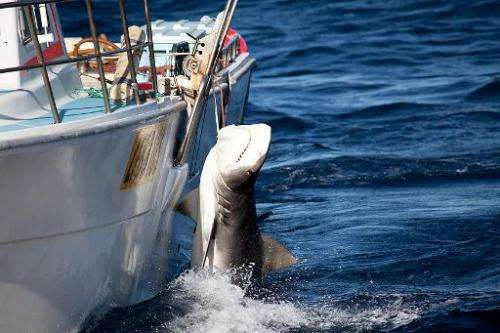Australia shark cull could snare more than 900

Australia's controversial shark cull could snare more than 900 animals over the next three years, a government review found, angering critics who said Tuesday most were caught needlessly.
Western Australia state has applied to national authorities to extend the policy designed to protect swimmers, under which sharks are captured using bait, and then killed if they are a threatening size.
It is not known how many of those captured will be destroyed, but in the three-month trial begun in January most animals were tagged and released.
Under the new proposal, released to the public by the state's Environmental Protection Authority on Monday, 72 baited hooks attached to floating drums will be put in place between November and April until 2017.
Most will be set one kilometre (around half a mile) offshore at the busiest beaches, with 12 kept in reserve when more lines are needed during a shark attack or threat.
"The deployment of drum lines is the most recent shark hazard mitigation measure to be considered by the government... to address the safety of water users," the state government said.
But the prospect of continued drum lines has angered conservationists who say it flies in the face of international obligations to protect the great white shark.
State opposition fisheries spokesman Dave Kelly told AFP the drum lines were also snaring tiger sharks, which were not responsible for the attacks.
About 900 tiger sharks and 25 great white sharks are projected to be caught during the cull. The drum lines will be taken down between May 1 and November 14 each year to avoid the annual migration of whales along Western Australia's coast.
"No one believes that tiger sharks have been responsible for the recent attacks here in Western Australia, so why target a species like tiger sharks when that's not going to have any impact on beach safety," Kelly said.
"The species that people think are responsible for most of the attacks are obviously great white sharks. If the (policy) is going to have minimal, if any, impact on great white shark numbers, that just begs the question—why do it?"
Sharks are common in Australian waters, and experts say attacks are increasing in line with population growth and the popularity of water sports.
There have been 170 fatal attacks in the last 100 years in Australia, according to the national Shark Attack File based at Sydney's Taronga Zoo.
© 2014 AFP





















